Life in the Submarine - The Mill Hill Missionaries
Life in the Submarine - The Mill Hill Missionaries
Life in the Submarine - The Mill Hill Missionaries
- No tags were found...
You also want an ePaper? Increase the reach of your titles
YUMPU automatically turns print PDFs into web optimized ePapers that Google loves.
<strong>Life</strong> <strong>in</strong> <strong>the</strong> Submar<strong>in</strong>eA huge swa<strong>the</strong> of light brownwater far out <strong>in</strong> <strong>the</strong> Atlantic was<strong>the</strong> tell-tale sign that we wereapproach<strong>in</strong>g our dest<strong>in</strong>ation.From <strong>the</strong>n on our ship wastravell<strong>in</strong>g <strong>in</strong> <strong>the</strong> waters of <strong>the</strong>m<strong>in</strong>d boggl<strong>in</strong>gly large CongoRiver. Not <strong>the</strong> fa<strong>in</strong>test glimmerof land <strong>in</strong> sight. In fact it tookano<strong>the</strong>r half day before a th<strong>in</strong>strip of coastal sandbeach withsome palm trees and <strong>the</strong>outl<strong>in</strong>e of <strong>the</strong> estuary of <strong>the</strong>Fellow passengersCongo river could bedist<strong>in</strong>guished far away on <strong>the</strong> horizon. F<strong>in</strong>ally, after two weeks at sea, and anemotional farewell at Antwerp, I would set eyes on <strong>the</strong> country and meet <strong>the</strong>people to whom I had been sent as a missionary by my congregation, <strong>the</strong> <strong>Mill</strong><strong>Hill</strong> <strong>Missionaries</strong>.It was <strong>the</strong> fulfilment of a long cherished dream. I had only a vague idea of whatwould be await<strong>in</strong>g me but was excited to explore this new and mysterious land<strong>in</strong> heart of Africa, <strong>the</strong> (former Belgian) Congo. <strong>The</strong> country had hit <strong>the</strong> headl<strong>in</strong>esworldwide at <strong>the</strong> time of its chaotic accession to <strong>in</strong>dependence <strong>in</strong> June 1960and had rema<strong>in</strong>ed <strong>in</strong> <strong>the</strong> spotlight ever s<strong>in</strong>ce exemplify<strong>in</strong>g, as it did, <strong>the</strong>nightmare scenario of never end<strong>in</strong>g violence and mayhem. Hundreds ofmissionaries had been killed dur<strong>in</strong>g <strong>the</strong> 1963-64 rebellion and <strong>the</strong> country wasonly just emerg<strong>in</strong>g from this traumatic episode under <strong>the</strong> <strong>the</strong>n promis<strong>in</strong>gleadership of Joseph Désiré Mobutu who had come to power <strong>in</strong> a military coup.<strong>The</strong> year of my arrival was 1968.Dur<strong>in</strong>g my f<strong>in</strong>al year at <strong>Mill</strong> <strong>Hill</strong>, London, we had been given <strong>the</strong> opportunity tomake our preferred missionary dest<strong>in</strong>ation known to our superiors. I had putPakistan on top of my list of favourites - stories about <strong>the</strong> work of missionaries<strong>the</strong>re and <strong>the</strong> contact with Muslims had grabbed my imag<strong>in</strong>ation - and foundat ord<strong>in</strong>ation time that I had been appo<strong>in</strong>ted to…..Congo. So Congo it wasgo<strong>in</strong>g to be! After a few months of brush<strong>in</strong>g up my French <strong>in</strong> a small rural parishcalled St Aub<strong>in</strong>, <strong>in</strong> <strong>the</strong> Sou<strong>the</strong>rn French ‘département’ of Lot et Garonne, I said
goodbye to my family and boarded ship at Antwerp <strong>in</strong> February 1968. Twoweeks later we arrived at Matadi. From <strong>the</strong>re <strong>the</strong> journey cont<strong>in</strong>ued by car toK<strong>in</strong>shasa and a few days later I boarded <strong>the</strong> plane for Basankusu.WakaFrans de Vrught, <strong>the</strong> societyrepresentative at <strong>the</strong> time andbishop Willem van Kesterenwere very welcom<strong>in</strong>g andwasted no time <strong>in</strong> tell<strong>in</strong>g mewhat my first appo<strong>in</strong>tment wasgo<strong>in</strong>g to be: I was to pitch mytent at Waka. <strong>The</strong> parish priest<strong>the</strong>re, Mar<strong>in</strong>us Boonman, aveteran Congo missionary, hada reputation of be<strong>in</strong>g an expertspeaker of <strong>the</strong> local triballanguage, Lomongo, and ofOh, those jiggers!possess<strong>in</strong>g a vast knowledge oflocal custom and traditions. He would be <strong>the</strong> ideal mentor, so <strong>the</strong> reason<strong>in</strong>gwent, of this green, <strong>in</strong>experienced youngster who had arrived with <strong>the</strong> oil oford<strong>in</strong>ation still wet on his hands. Bro<strong>the</strong>r Piet Tweehuijsen was also stationedat Waka as was Piet Korse whom I was meant to replace.I was grateful for this opportunity of what looked like a ‘soft land<strong>in</strong>g’ – firstgett<strong>in</strong>g a decent ground<strong>in</strong>g <strong>in</strong> <strong>the</strong> language and acquir<strong>in</strong>g a basic knowledge of<strong>the</strong> culture and traditions of <strong>the</strong> people- before launch<strong>in</strong>g <strong>in</strong>to amissionary/pastoral m<strong>in</strong>istry. But th<strong>in</strong>gs rarely work out as expected orplanned, certa<strong>in</strong>ly not <strong>in</strong> Congo where, as I discovered and came to cherishover <strong>the</strong> years, people readily welcome <strong>the</strong> unexpected and have developedimprovisation <strong>in</strong>to a f<strong>in</strong>e art. Expressions like ‘Système D’, (débrouillez-vous –improvise), ‘article 15’ and ‘tomeka’ and o<strong>the</strong>r similar jocular terms referr<strong>in</strong>g to<strong>the</strong> need to make do were <strong>the</strong> warp and woof of daily conversation.My anticipated ‘soft land<strong>in</strong>g’ soon turned <strong>in</strong>to a suitably bumpy ride as <strong>the</strong>reality of <strong>the</strong> extreme isolation of <strong>the</strong> area began to s<strong>in</strong>k <strong>in</strong>. <strong>The</strong> somewhatstifl<strong>in</strong>g embrace of <strong>the</strong> omnipresent ra<strong>in</strong>forest cover<strong>in</strong>g <strong>the</strong> whole of <strong>the</strong>diocese and far beyond <strong>in</strong>evitably generated a long<strong>in</strong>g for <strong>the</strong> wide horizons of
my native Holland. Our only means of contact with <strong>the</strong> outside world was aonce daily radio call which l<strong>in</strong>ked <strong>the</strong> various mission stations with each o<strong>the</strong>rand with <strong>the</strong> largest village <strong>in</strong> <strong>the</strong> diocese, Basankusu. <strong>The</strong> Procure <strong>in</strong>Basankusu was <strong>the</strong> only place with equipment powerful enough tocommunicate directly with K<strong>in</strong>shasa and from <strong>the</strong>re with Europe. <strong>The</strong> postalservice was erratic at best and letters would take weeks, sometimes months toarrive.To counterbalance this feel<strong>in</strong>g of isolation <strong>the</strong>re was an excellent spirit ofcamaraderie among <strong>the</strong> 30 odd <strong>Mill</strong> <strong>Hill</strong> missionaries <strong>in</strong> <strong>the</strong> diocese ofBasankusu, but mission stations were few and far between. Basankusu was ata distance of 80 kms from Waka and Bar<strong>in</strong>ga, <strong>the</strong> next station <strong>in</strong> <strong>the</strong> o<strong>the</strong>rdirection, was even fur<strong>the</strong>r away. Transport <strong>in</strong> <strong>the</strong> ra<strong>in</strong>forest is difficult at <strong>the</strong>best of times, but downright impossible <strong>in</strong> <strong>the</strong> ra<strong>in</strong>y season. <strong>The</strong>re was not onesquare centimeter of tarmac <strong>in</strong> <strong>the</strong> whole of <strong>the</strong> diocese, few properlyconstructed bridges over <strong>the</strong> numerous rivers and streams, and unreliableferries at <strong>the</strong> large river cross<strong>in</strong>gs. Bishop Cornelio de Wit, our one timeSuperior General, famously remarked on his only visit to <strong>the</strong> diocese: “Yourexistence here is like liv<strong>in</strong>g <strong>in</strong> a green submar<strong>in</strong>e” – with a reference to <strong>the</strong>famous Beatles song ‘We all live <strong>in</strong> a yellow submar<strong>in</strong>e’ which was popular at<strong>the</strong> time.But physical isolation was butone element of what developed<strong>in</strong>to an experience of cultureshock ‘squared’. <strong>The</strong> <strong>in</strong>abilityto communicate adequatelywith <strong>the</strong> people aroundbecause of not speak<strong>in</strong>g <strong>the</strong>language was hugelyconfrontational. I have neverfelt so helpless <strong>in</strong> my life. Smallkids would po<strong>in</strong>t at this‘bondele’ – white man - <strong>in</strong> utterastonishment say<strong>in</strong>g: “He is agrown man and does not know how to speak, and we are only kids. Ourlanguage is so easy – even we, kids, can speak it!” Mar<strong>in</strong>us Boonman, mymentor, was an excellent speaker, but had little <strong>in</strong>cl<strong>in</strong>ation to teach. For mypart, I soon discovered that my preferred method of language learn<strong>in</strong>g was touse a grammar so as to be able to understand <strong>the</strong> structure of <strong>the</strong> language.As luck would have it <strong>the</strong>re was a Lomongo grammar available and an excellent
dictionary too, plus a wealth of o<strong>the</strong>r material all produced by a Belgian SacredHeart missionary called Gustave Hulstaert, a l<strong>in</strong>guistic genious. Thanks to hisuntir<strong>in</strong>g efforts at collect<strong>in</strong>g l<strong>in</strong>guistic and cultural data, ever s<strong>in</strong>ce <strong>the</strong> 1930’s,and his multifaceted scientific ability, <strong>the</strong> language of <strong>the</strong> Mongo people hasbecome one of <strong>the</strong> best documented and most fully analysed <strong>in</strong> <strong>the</strong> whole ofAfrica.Right <strong>in</strong> <strong>the</strong> middle of this ra<strong>the</strong>r pa<strong>in</strong>ful learn<strong>in</strong>g process, after only a fewweeks at Waka, Piet Korse <strong>in</strong>vited me to accompany him on a week’s pastoraltour of a number of villages <strong>in</strong> <strong>the</strong> Bolima area, a journey ‘<strong>in</strong>to <strong>the</strong> <strong>in</strong>terior’ as<strong>the</strong> expression went. Piet obviously had decided that a baptism of fire – ‘s<strong>in</strong>kor swim’ – would do me a world of good and would provide an excellentopportunity to cont<strong>in</strong>ue <strong>the</strong> learn<strong>in</strong>g process at <strong>the</strong> grassroots. So off we wentsome distance along <strong>the</strong> road l<strong>in</strong>k<strong>in</strong>g Waka to Bar<strong>in</strong>ga. I had thought of stay<strong>in</strong>g<strong>in</strong> <strong>the</strong> shadows of Piet <strong>in</strong> order to learn from his experience s<strong>in</strong>ce this was myfirst exposure to such a ‘safari’. But Piet had o<strong>the</strong>r ideas. When we arrived at<strong>the</strong> first village – Bolima Ekonda was <strong>the</strong> name, I th<strong>in</strong>k – he <strong>in</strong>troduced me to<strong>the</strong> local catechist and <strong>the</strong>n left me <strong>the</strong>re, whilst he himself cont<strong>in</strong>ued to <strong>the</strong>next village. “I’ll come and collect you tomorrow afternoon…..” So <strong>the</strong>re I was,with hardly a word of Lomongo, feel<strong>in</strong>g as <strong>in</strong>adequate as I will ever feel. I don’tremember what happened next morn<strong>in</strong>g, but I must have struggled through <strong>the</strong>text of <strong>the</strong> Mass with <strong>the</strong> help of <strong>the</strong> catechist – read<strong>in</strong>g a text <strong>in</strong> a Bantulanguage usually is not difficult, but to be understood at all you have to master<strong>the</strong> tonal system, an altoge<strong>the</strong>r more arduous undertak<strong>in</strong>g.Anyway, I survived this ‘existential crisis’. After roughly three months I had a fairsmatter<strong>in</strong>g of <strong>the</strong> language and could make myself understood. I began to feelmore at ease and from <strong>the</strong>n on a real ‘love story’ started to develop: I took aprofound lik<strong>in</strong>g both to <strong>the</strong> people and <strong>the</strong> forest. An endur<strong>in</strong>g <strong>in</strong>terest <strong>in</strong>everyth<strong>in</strong>g African, culture and <strong>in</strong>culturation, as well as <strong>in</strong> trees and plants, anda passion for orchids was <strong>the</strong> result.A few storiesAlthough I only spent just over a year <strong>in</strong> Waka I have many vivid memories of<strong>the</strong> first missionary experience. A few cameo’s.<strong>The</strong> apprehension and excitement of go<strong>in</strong>g on my first weekend trip <strong>in</strong>to <strong>the</strong><strong>in</strong>terior on my own, sleep<strong>in</strong>g <strong>in</strong> <strong>the</strong> house of <strong>the</strong> headmaster, watch<strong>in</strong>g <strong>the</strong>
villagers keep<strong>in</strong>g <strong>the</strong> elephantsat bay that even<strong>in</strong>g and f<strong>in</strong>d<strong>in</strong>ghuge elephant footpr<strong>in</strong>ts allaround <strong>the</strong> house <strong>the</strong> nextmorn<strong>in</strong>g.And an outbreak of smallpox <strong>in</strong>Waka – it must have been oneof <strong>the</strong> last <strong>in</strong> Africa, becausesomewhere <strong>in</strong> <strong>the</strong> 70’s <strong>the</strong>WHO announced that <strong>the</strong>disease had been eradicatedworldwide. Several people diedElephant hunt<strong>in</strong>ga horrible death, among <strong>the</strong>m<strong>the</strong> only fully qualified D6 teacher at <strong>the</strong> mission primary school, a young mancalled Jean-Paul Bokungu. I felt quite heroic at <strong>the</strong> time of <strong>the</strong> burial when noone dared to touch <strong>the</strong> coff<strong>in</strong> for fear of contam<strong>in</strong>ation and Mar<strong>in</strong>us Boonmanand myself alone had to lower <strong>the</strong> coff<strong>in</strong> <strong>in</strong>to <strong>the</strong> grave.‘Crestfallen’ would be <strong>the</strong> bestway to describe my feel<strong>in</strong>gswhen through <strong>in</strong>experienceand a wrong move I gothopelessly stuck driv<strong>in</strong>g <strong>the</strong>ancient Volkswagen Kombithrough <strong>the</strong> marshesseparat<strong>in</strong>g Waka from <strong>the</strong>Lifumba area. I had been sentto collect <strong>the</strong> dead body of aparishioner whose family hadrequested a transfer toBasankusu. Maybe <strong>the</strong> firstencounter with heart rend<strong>in</strong>g African wail<strong>in</strong>g had also affected my nerves!Little did I know <strong>the</strong>n that this would be <strong>the</strong> first of many such experiences oftravel misery <strong>in</strong> years to come.<strong>The</strong> technological revolution to hit even <strong>the</strong> remotest outpost of <strong>the</strong> ra<strong>in</strong>forestat <strong>the</strong> time was <strong>the</strong> transistor radio. <strong>The</strong> short wave news broadcasts,especially BBC Worldservice, were <strong>the</strong> only way to keep up with what was go<strong>in</strong>gon above and beyond <strong>the</strong> ra<strong>in</strong>forest canopy. <strong>The</strong> Americans were prepar<strong>in</strong>g <strong>the</strong>Apollo Moon land<strong>in</strong>g at <strong>the</strong> time. I happened to be on safari at Ndeke, a large
oil palm plantation with<strong>in</strong> <strong>the</strong> area of <strong>the</strong> parish of Waka when Armstrong c.s.landed. That night I sat around for a chat outside with primary school teacherRaphael Iwoku and a few o<strong>the</strong>rs. <strong>The</strong> moon shone bright from <strong>the</strong> cloudlessAfrican sky. “Do you see <strong>the</strong> moon?”, I asked, and <strong>the</strong>n po<strong>in</strong>ted out excitedlywhat was happen<strong>in</strong>g <strong>the</strong>re at that very moment. People walk<strong>in</strong>g on <strong>the</strong> moon?A look of astonished <strong>in</strong>comprehension was all it solicited. Those ‘bendele’ and<strong>the</strong>ir stories…..After just over a year of acclimatisation and <strong>in</strong>itiation <strong>in</strong>to <strong>the</strong> language andculture of <strong>the</strong> Mongo people <strong>in</strong> Waka I was asked to return to Europe to get alicentiate degree <strong>in</strong> Romance Philology (French and l<strong>in</strong>guistics) at Louva<strong>in</strong>University <strong>in</strong> preparation for a post<strong>in</strong>g as a teacher at one of <strong>the</strong> two secondaryschools of <strong>the</strong> diocese. And so I left Waka <strong>in</strong> June 1969 to start <strong>the</strong> process ofenrolment at Louva<strong>in</strong> University. Some fellow MHMs <strong>in</strong> Basankusu, I heardlater, thought I would never return. Little did <strong>the</strong>y know that strength ofattraction I felt for <strong>the</strong> people and <strong>the</strong> area after that one year’s <strong>in</strong>itiation! Andso, after an <strong>in</strong>terlude of four years - a description of my experiences of studentlife and university studies, a whole new and <strong>in</strong> many ways excit<strong>in</strong>g world,constitutes a different chapter altoge<strong>the</strong>r and will not here be <strong>in</strong>cluded – Ireturned to Congo and was appo<strong>in</strong>ted to <strong>the</strong> secondary school at Bonkita.BonkitaSituated at about 18 kms from Basankusu on <strong>the</strong> banks of <strong>the</strong> Lulonga river, atributary of <strong>the</strong> majestic Congo river, Bonkita was an idyllic spot, one of <strong>the</strong> fewplaces <strong>in</strong> <strong>the</strong> diocese which afforded a wide view over <strong>the</strong> surround<strong>in</strong>g area anda horizon not curtailed by giant ra<strong>in</strong>forest trees. You could swim <strong>in</strong> <strong>the</strong> river<strong>the</strong>re, which I did almost on a daily basis. That is to say if you took <strong>the</strong> warn<strong>in</strong>gsabout crocodiles with a p<strong>in</strong>ch of salt. I never saw one <strong>in</strong> all those years,although <strong>the</strong>re were plenty of relatively harmless small alligators, usually <strong>in</strong>small streams <strong>in</strong> marshes <strong>in</strong> <strong>the</strong> forest. <strong>The</strong> people hunted and ate <strong>the</strong>se,ra<strong>the</strong>r than <strong>the</strong> o<strong>the</strong>r way round! I learnt to row <strong>in</strong> an African dugout canoe andmade regular row<strong>in</strong>g trips around <strong>the</strong> large island right <strong>in</strong> front of <strong>the</strong> house atBonkita. Peace Corps volunteers work<strong>in</strong>g <strong>in</strong> schools around <strong>the</strong> diocese lovedto come and visit <strong>the</strong>ir friends teach<strong>in</strong>g English and o<strong>the</strong>r subjects at Likong’aNguwa, Bonkita.Fons Mertens, a veteran missionary and member of <strong>the</strong> Bonkita team (toge<strong>the</strong>rwith Wim Beentjes and – <strong>in</strong>itially - Jan Hendriks, and Gerrit Gerritsen for <strong>the</strong>
attention of <strong>the</strong> class was never a problem. <strong>The</strong>y were motivated. But <strong>the</strong>irprogress was bedevilled by habits of rote learn<strong>in</strong>g hammered <strong>in</strong>to <strong>the</strong>m atprimary school level. It took enormous effort to awaken <strong>in</strong> <strong>the</strong>m a spirit ofcreativity and critical th<strong>in</strong>k<strong>in</strong>g. Most were quite content to regurgitate what <strong>the</strong>teacher had told <strong>the</strong>m even <strong>in</strong> <strong>the</strong> f<strong>in</strong>al year of secondary education. <strong>The</strong>enchanted (belief <strong>in</strong> magic) universe <strong>the</strong>y lived <strong>in</strong> favoured chance over abilityand hard work. When f<strong>in</strong>al exams came around students could be seen to put<strong>the</strong>ir writ<strong>in</strong>g utensils on <strong>the</strong> tombs of deceased early missionaries at Bokakata,presumably to magically absorb <strong>the</strong> knowledge of <strong>the</strong>se ‘superior’ whitepeople. In <strong>the</strong> tribal society <strong>the</strong>y lived <strong>in</strong> what mattered was patronage and whoyou were related to, not ability and genu<strong>in</strong>e expertise. Education, so it dawnedon most of us <strong>in</strong>volved <strong>in</strong> it, had to set as its ultimate goal not just <strong>the</strong> impart<strong>in</strong>gof knowledge, but a veritable ‘metanoia’, a different way of th<strong>in</strong>k<strong>in</strong>g and be<strong>in</strong>g.Talk about long term objectives…! I hope that toge<strong>the</strong>r with <strong>the</strong> o<strong>the</strong>r membersof <strong>the</strong> staff at Likong’a Nguwa dur<strong>in</strong>g my seven years of direct <strong>in</strong>volvement atclassroom level I have made even <strong>the</strong> t<strong>in</strong>iest contribution towards progress onthat arduous road.<strong>The</strong> school at Bonkita had quite a chequered history. It had <strong>in</strong>itially been set up<strong>in</strong> <strong>the</strong> 1950’s as an agricultural school. When that proved difficult to ma<strong>in</strong>ta<strong>in</strong>it was turned <strong>in</strong>to a m<strong>in</strong>or sem<strong>in</strong>ary with a board<strong>in</strong>g facility. This <strong>in</strong> turn wastransformed <strong>in</strong>to a regular secondary school – ‘section littéraire and biochimie’- under <strong>the</strong> name Institut Likong’a Nguwa at <strong>the</strong> time of <strong>the</strong> countrywide reform of education dur<strong>in</strong>g <strong>the</strong> 1970’s. Jan Hendriks, who had been <strong>the</strong>m<strong>in</strong>or sem<strong>in</strong>ary director, presided over this transition and <strong>in</strong> <strong>the</strong> mid 1970’shanded over to an able Congolese headmaster called Joseph Bongwele. Thisappo<strong>in</strong>tment had been strongly promoted by <strong>the</strong> first Congolese bishop ofBasankusu, Mgr Ignace Matondo kwa Nzambi cicm. Clearly ‘<strong>the</strong> times <strong>the</strong>ywere a-chang<strong>in</strong>g’!Bishop Matondo kwa Nzambi<strong>The</strong> arrival of Mgr Ignace Matondo kwa Nzambi, a Congolese Missionary ofScheut, follow<strong>in</strong>g <strong>the</strong> unobtrusive resignation and stealthy departure of Mgrvan Kester and a number of months of ‘<strong>in</strong>terregnum’, was greeted with somescepticism by <strong>the</strong> local clergy who had <strong>the</strong>ir own ambitions and considerablejoy comb<strong>in</strong>ed with huge expectations by <strong>the</strong> general population.<strong>The</strong> months of apostolic adm<strong>in</strong>istration had been difficult. Jan Hendriks, <strong>the</strong>
apostolic adm<strong>in</strong>istrator had puta brave face to it and had kept<strong>the</strong> diocese go<strong>in</strong>g to <strong>the</strong> best ofhis ability. At Bonkita <strong>in</strong> 1975at <strong>the</strong> end of <strong>the</strong> school yearwe stored every piece ofvaluable equipment <strong>in</strong> <strong>the</strong>small chapel and sealed it off.Everyone went on home leave,except for myself, amidconsiderable uncerta<strong>in</strong>ty as towhat <strong>the</strong> future would br<strong>in</strong>g. Istill remember <strong>the</strong> feel<strong>in</strong>g ofresponsibility and considerable Bishop Matondo at ord<strong>in</strong>ation ceremonyapprehension when those summer holidays started – I had only been <strong>in</strong> <strong>the</strong>place for two years.Both <strong>the</strong> diocese and <strong>the</strong> country as a whole were go<strong>in</strong>g through a period ofuncerta<strong>in</strong> transition. As it turned out, <strong>the</strong> national campaign of ‘au<strong>the</strong>nticité’and ‘zaïreanisation’ (read: m<strong>in</strong>dless nationalisation) <strong>in</strong>itiated around this timeby President Mobutu, largely as a political ploy, proved hugelycounterproductive <strong>in</strong> <strong>the</strong> long run and quickened <strong>the</strong> country’s headlong rushtowards economic ru<strong>in</strong>. <strong>The</strong> abolition of Christian names <strong>in</strong> <strong>the</strong> name of Africanau<strong>the</strong>nticity led to a conflict with <strong>the</strong> Catholic Church and <strong>the</strong> temporarydeparture <strong>in</strong>to exile of Card<strong>in</strong>al Malula. <strong>The</strong> latter had himself spearheaded amuch sounder form of africanisation of <strong>the</strong> Catholic Church famously stat<strong>in</strong>g: ”A new baby is be<strong>in</strong>g born here, and we can be sure of one th<strong>in</strong>g: it will beblack!” <strong>The</strong> irony of <strong>the</strong> situation escaped no one.At <strong>the</strong> local diocesan level bishop Matondo’spromotion of <strong>in</strong>culturation felt real and promis<strong>in</strong>g.In fact bishop Matondo <strong>in</strong> his early years cameacross as hugely charismatic and <strong>in</strong>spir<strong>in</strong>g. Hewould prove to be someone who would br<strong>in</strong>g aboutsubstantial change <strong>in</strong> <strong>the</strong> diocese aga<strong>in</strong>stconsiderable odds. Most noticeable were <strong>the</strong>changes <strong>in</strong> <strong>the</strong> way we celebrated <strong>the</strong> liturgy. Tounify <strong>the</strong> diocese and br<strong>in</strong>g it <strong>in</strong> l<strong>in</strong>e with <strong>the</strong> rest of<strong>the</strong> ecclesiastical prov<strong>in</strong>ce he <strong>in</strong>troduced L<strong>in</strong>gala,one of <strong>the</strong> four national languages and a l<strong>in</strong>guafranca <strong>in</strong> most of <strong>the</strong> country, as <strong>the</strong> only language
of <strong>the</strong> liturgy. Not everyone was happy with this change as a lot of effort hadbeen put <strong>in</strong>to promot<strong>in</strong>g local languages, <strong>in</strong> particular Lomongo. Aconsiderable amount of liturgical and catechetical material had been written <strong>in</strong>this language for distribution <strong>in</strong> several dioceses <strong>in</strong> <strong>the</strong> Equator prov<strong>in</strong>ce.Toge<strong>the</strong>r with <strong>the</strong> change of language came a change of rite. For some timeCongolese liturgists under <strong>the</strong> guidance and <strong>in</strong>spiration of Card<strong>in</strong>al Malula hadbeen work<strong>in</strong>g on a Zaïrean rite of <strong>the</strong> Mass. Rome had given permission to usethis Africanised form of <strong>the</strong> Eucharist for a number of years ‘ad experimentum’.At <strong>the</strong> <strong>in</strong>stigation of bishop Matondo <strong>the</strong> diocese of Basankusu enthusiasticallyjo<strong>in</strong>ed <strong>in</strong> <strong>the</strong> experiment. And what a change it was! <strong>The</strong> lively hymns <strong>in</strong> L<strong>in</strong>galasung at <strong>the</strong> episcopal ord<strong>in</strong>ation of bishop Matondo became <strong>in</strong>stant hitsamong young and old alike. Liturgical celebrations <strong>the</strong>reafter quickly turned<strong>in</strong>to colourful feasts of rhythm and song and dance. It felt as if <strong>the</strong> celebrationof <strong>the</strong> Eucharist had f<strong>in</strong>ally ‘come home’ to Africa.A well thought out pastoral plan <strong>in</strong>volv<strong>in</strong>g among o<strong>the</strong>r <strong>in</strong>novations <strong>the</strong> creationof CEBs (Basic Christian Communities), lay m<strong>in</strong>istries and <strong>the</strong> appo<strong>in</strong>tment ofBakambi (lay persons <strong>in</strong> charge of a parish) put a spr<strong>in</strong>g <strong>in</strong>to <strong>the</strong> flagg<strong>in</strong>g stepof church life of <strong>the</strong> diocese. <strong>The</strong> ensu<strong>in</strong>g closure of <strong>the</strong> Formation Centre forCatechists <strong>in</strong> Mampoko was not to everyone’s lik<strong>in</strong>g. Catechists, it was clear,would no longer be an essential l<strong>in</strong>k between priest and people – <strong>the</strong>leadership of <strong>the</strong> community would be shared with o<strong>the</strong>r lay m<strong>in</strong>isters. <strong>The</strong>parish would become a ‘community of communities’. Was this <strong>in</strong>tended breakdownof <strong>the</strong> hierarchical pyramid really go<strong>in</strong>g to work?Most <strong>in</strong>novative of all was bishop Matondo’s <strong>in</strong>troduction of <strong>the</strong> Bilenge yaMw<strong>in</strong>da (Youth of <strong>the</strong> Light), a thoroughly Africanised <strong>in</strong>itiation of <strong>the</strong> youth <strong>in</strong>to<strong>the</strong> Christian faith. When hewas still parish priest ofMatete, a suburb of <strong>the</strong>sprawl<strong>in</strong>g capital K<strong>in</strong>shasa,Père Ignace Matondo, hadfounded and developed thisyouth ‘movement’ <strong>in</strong> responseto President Mobutu’ssuppression of any form ofreligious <strong>in</strong>struction <strong>in</strong> schools<strong>in</strong> <strong>the</strong> name of au<strong>the</strong>nticity.“Nkombo ya yo Nkolo”, aslightly rebellious hymn
<strong>in</strong>troduced at <strong>the</strong> time, became <strong>the</strong> signature tune of <strong>the</strong> Bilenge ya Mw<strong>in</strong>da.Hav<strong>in</strong>g <strong>the</strong> founder and chief <strong>in</strong>itiator of this strik<strong>in</strong>g pastoral <strong>in</strong>itiative at <strong>the</strong>helm of <strong>the</strong> diocese exercised a huge attraction young people all around. Manyof <strong>the</strong> students at Bonkita, where I was teach<strong>in</strong>g, also got <strong>in</strong>volved. Iexperienced this development as a real gift of <strong>the</strong> Spirit and was grateful for<strong>the</strong> opportunity it afforded to acqua<strong>in</strong>t <strong>the</strong> youth with <strong>the</strong> Gospel message <strong>in</strong> alanguage and a manner <strong>the</strong>y could understand and relate to. Regularly everyyear bishop Matondo would write an extensive letter <strong>in</strong> <strong>the</strong> form of a brochureto <strong>the</strong> Bilenge ya Mw<strong>in</strong>da all over <strong>the</strong> country. It took a while to fully appropriate<strong>the</strong> thoroughly African process of <strong>in</strong>itiation which lay at <strong>the</strong> roots of <strong>the</strong> methodproposed by bishop Matondo. <strong>The</strong> fact that most young people had noawareness or experience of traditional tribal <strong>in</strong>itiation also did not help. But atleast everyone could recognise <strong>the</strong> approach as truly African.Africa has a rich oral tradition. In Central Africa <strong>the</strong>re are no written sourcespredat<strong>in</strong>g <strong>the</strong> colonial period. Important historical events were handed on byword of mouth and committed to memory with amaz<strong>in</strong>g accuracy. A well-knownBelgian scholar, Jan Vans<strong>in</strong>a, has been able to trace back <strong>the</strong> l<strong>in</strong>eage of <strong>the</strong>K<strong>in</strong>gs of <strong>the</strong> Bakuba K<strong>in</strong>gdom <strong>in</strong> Congo to <strong>the</strong> sixteenth century us<strong>in</strong>g oralsources. David van Reybrouck <strong>in</strong> recent his history of Congo, published toco<strong>in</strong>cide with <strong>the</strong> 50th anniversary of <strong>the</strong> country’s <strong>in</strong>dependence, makesextensive use of <strong>in</strong>formants.Similarly Bishop Matondo was conscious of be<strong>in</strong>g heir to a culture centredaround ‘le Verbe’, as <strong>the</strong> French expression goes. “And <strong>the</strong> Word was madeflesh”. He was an excellent orator. His sermons and conferences were alwayswell prepared. I often saw him walk<strong>in</strong>g up and down <strong>the</strong> veranda of hisresidence’ th<strong>in</strong>k<strong>in</strong>g ‘aloud’ to test and develop <strong>the</strong> flow of an sermon or a talk.His lively sermons <strong>in</strong> true African style would be peppered with proverbs,stories, an occasional song and plenty of rhetorical questions to which <strong>the</strong>audience would respond <strong>in</strong>stantly as <strong>the</strong>y would at a village ga<strong>the</strong>r<strong>in</strong>g. Oftenhe would be carried away by his own enthusiasm, sweat<strong>in</strong>g profusely andgesticulat<strong>in</strong>g wildly to <strong>the</strong> po<strong>in</strong>t of almost los<strong>in</strong>g his mitre (bishops wear <strong>the</strong>irmitre when <strong>the</strong>y preach!). African oratory is generous <strong>in</strong> its use of time too. AEuropean style ten m<strong>in</strong>ute sermon leaves most Congolese ‘hungry’. AEucharist celebrated <strong>in</strong> <strong>the</strong> Zaïrean rite typically lasts two hours or more – <strong>the</strong>sermon tak<strong>in</strong>g half an hour at least. <strong>The</strong> art of exuberant celebration – religioncan be fun! – is one of Africa’s most precious contributions to <strong>the</strong> universalChurch, <strong>in</strong> my estimation. <strong>The</strong> longest celebration I ever attended was anEaster Vigil at Basankusu Ca<strong>the</strong>dral which started at 8 pm and f<strong>in</strong>ished wellpast midnight! Some <strong>in</strong>veterate smokers among my fellow missionaries would
at times, abscond dur<strong>in</strong>g <strong>the</strong> sermon, have a smoke, and f<strong>in</strong>d <strong>the</strong> bishop still<strong>in</strong> full oratorical sw<strong>in</strong>g when <strong>the</strong>y returned!In a support<strong>in</strong>g roleIn 1980 bishop Matondo asked me to become his Vicar General and appo<strong>in</strong>tedme Conseiller Pédagogique of secondary education <strong>in</strong> <strong>the</strong> diocese. JosephBongwele had been appo<strong>in</strong>ted chief Coord<strong>in</strong>ator of Education at <strong>the</strong> same timeand we were to work closely toge<strong>the</strong>r to build up secondary education <strong>in</strong> <strong>the</strong>diocese. I was truly delighted to be able to work as an assistant to Congoleseleaders (Bishop, Coord<strong>in</strong>ator), no longer <strong>in</strong> <strong>the</strong> driv<strong>in</strong>g seat, but <strong>in</strong> a supportivecapacity as I deeply felt <strong>the</strong> position of <strong>the</strong> missionary should be at this stageof <strong>the</strong> development of <strong>the</strong> Church <strong>in</strong> Congo.<strong>The</strong>re had been a sudden and quite anarchic explosion of <strong>the</strong> number ofsecondary schools all over <strong>the</strong> diocese – Catholic, Baptist, Kimbanguist,Islamic and State – <strong>in</strong> response to chang<strong>in</strong>g government policy. To say that <strong>in</strong><strong>the</strong> absence of even <strong>the</strong> most basic <strong>in</strong>frastructure, with no textbooks or writ<strong>in</strong>gmaterial to speak of, and a host of poorly qualified teachers, giv<strong>in</strong>g somedirection to this chaotic growth was go<strong>in</strong>g to be an uphill task, would have been<strong>the</strong> understatement of <strong>the</strong> decade. But Joseph Bongwele was not easily putout by adverse conditions. He had <strong>the</strong> trust of <strong>the</strong> teach<strong>in</strong>g personnel and abasic honesty <strong>in</strong> handl<strong>in</strong>g money. Dick van de Riet, who oversaw <strong>the</strong> f<strong>in</strong>ancialdepartment of <strong>the</strong> Education Office, was a huge support as well.For <strong>the</strong> school at Bonkita with its onerous board<strong>in</strong>g facility, which proved moreand more difficult to ma<strong>in</strong>ta<strong>in</strong>, this proliferation of secondary schools provedfatal. <strong>The</strong> new préfet, Nyenge,valiantly struggled to keep <strong>the</strong>place go<strong>in</strong>g, but <strong>in</strong> <strong>the</strong> end fellvictim to <strong>the</strong> wide spread habitof ‘creative account<strong>in</strong>g’ andwas transferred. Not long after<strong>the</strong> entire school was moved toBasankusu to cramped and<strong>in</strong>adequate accommodation atwhat had previously been aCycle d’Orientation (<strong>the</strong> firsttwo preparatory years before
secondary education proper), and became a day school. <strong>The</strong> school build<strong>in</strong>gsat Bonkita returned to <strong>the</strong>ir orig<strong>in</strong>al dest<strong>in</strong>ation to accommodate <strong>the</strong> A.I.F.(Année Initiatique de Formation), a one year preparatory course for candidatesfor <strong>the</strong> major sem<strong>in</strong>ary, a bra<strong>in</strong> child of <strong>the</strong> ever creative bishop Matondo, ofwhich I was <strong>in</strong>itially put <strong>in</strong> charge. <strong>The</strong> ma<strong>in</strong> U shaped build<strong>in</strong>g consist<strong>in</strong>g of<strong>the</strong> student dormitory, chapel and accommodation for teach<strong>in</strong>g staff wastransformed <strong>in</strong>to a much needed pastoral centre for group tra<strong>in</strong><strong>in</strong>gs, retreats,workshops and <strong>the</strong> like.As for me, I was happy to be able to keep my base at Bonkita, but as aconsequence of my new responsibilities began to lead a quite nomadicexistence. Over <strong>the</strong> next seven years till I left <strong>the</strong> diocese <strong>in</strong> 1988 I travelled<strong>the</strong> length and breadth of <strong>the</strong> diocese ( some 800 kms from one end to <strong>the</strong>o<strong>the</strong>r) several times a year, got hopelessly stuck <strong>in</strong> swamps on numerousoccasions, had to cut my way through <strong>the</strong> forest once to circumvent one ofthose giant ra<strong>in</strong>forest trees which had fallen over <strong>the</strong> road, and generally led anomadic existence. I enjoyed mov<strong>in</strong>g around, visit<strong>in</strong>g fellow missionaries <strong>in</strong>every corner of <strong>the</strong> diocese, and giv<strong>in</strong>g whatever assistance I could to wellmean<strong>in</strong>gbut struggl<strong>in</strong>g headmasters and <strong>in</strong>adequate or dishonest ones alike.Willy Lokose, an expert teacher of French, became a trusted companion fordur<strong>in</strong>g my f<strong>in</strong>al years on some of <strong>the</strong>se trips. He would occasionally give modellessons and would generally be quick <strong>in</strong> pick<strong>in</strong>g up relational or o<strong>the</strong>r problemsrag<strong>in</strong>g underneath <strong>the</strong> surface. One day he rescued me from a particularlysticky situation when an irate teacher threatened me with a machete. I reallysympathised with <strong>the</strong> man because was go<strong>in</strong>g to be made redundant for lackof proper qualification. I only wish he had chosen someone else to vent hisanger on! <strong>The</strong> sad fact was that <strong>the</strong> payment of teachers dur<strong>in</strong>g <strong>the</strong> course of<strong>the</strong> 1980s became more and more erratic and <strong>the</strong> level of remunerationwoefully <strong>in</strong>sufficient as <strong>the</strong> country slid fur<strong>the</strong>r down <strong>the</strong> road of economic ru<strong>in</strong>due to Mobutu’s <strong>in</strong>creas<strong>in</strong>gly kleptocratic regime.<strong>The</strong> 4x4 Toyota Landcuiser was our preferred means of transport on <strong>the</strong> oftentreacherous forest roads.<strong>The</strong> ra<strong>in</strong>forest equivalent of <strong>the</strong> desert camel. M<strong>in</strong>ewas equipped with a w<strong>in</strong>ch and a specially adapted jack to lift <strong>the</strong> car whenoccasionally a wheel would slide <strong>in</strong>to <strong>the</strong> space between two logs on makeshiftbridges, especially after a heavy downpour. On one of those trips, a 2-3 weekodyssey to visit <strong>the</strong> far end of <strong>the</strong> diocese, <strong>the</strong> Bongando area, <strong>the</strong> car wasoverloaded as often happened. Some 20 kms out of Basankusu I had to stopbecause <strong>the</strong> load began to shift. When I tried to readjust a piece of luggage Iviolently hit <strong>the</strong> back of my head aga<strong>in</strong>st a protrud<strong>in</strong>g piece of metal at <strong>the</strong> car’s
ceil<strong>in</strong>g meant to hold <strong>the</strong> door shut. <strong>The</strong> wound was deep and I was bleed<strong>in</strong>gprofusely. <strong>The</strong> water of a nearby stream helped to wash away <strong>the</strong> blood andeventually <strong>the</strong> bleed<strong>in</strong>g stopped. We decided to cont<strong>in</strong>ue our journey. Just pastWaka we ran <strong>in</strong>to Sr Joseph<strong>in</strong>e who was on one of her medical trips <strong>in</strong>to <strong>the</strong><strong>in</strong>terior. She took one look at <strong>the</strong> wound and decided it needed to be stitched.Be<strong>in</strong>g a no nonsense practical Flemish nun she proposed to set to work right<strong>the</strong>re <strong>in</strong> <strong>the</strong> village. And so she did. <strong>The</strong> scar was visible for quite some years<strong>the</strong>reafter, but eventually disappeared. Rock hard missionaries? You had littlechoice <strong>in</strong> those circumstances.Cross<strong>in</strong>g <strong>the</strong> two ma<strong>in</strong> rivers <strong>in</strong><strong>the</strong> diocese, <strong>the</strong> Mar<strong>in</strong>ga and<strong>the</strong> Lopori, both tributaries of‘Le Fleuve’ (<strong>the</strong> Congo River),was always an adventure on<strong>the</strong>se journeys. When youarrived at <strong>the</strong> ‘bac’ (ferry) atSamba you never knewbeforehand what would berequired to make <strong>the</strong> cross<strong>in</strong>g.Sometimes, when <strong>the</strong> ferry layidle at <strong>the</strong> opposite bank, <strong>the</strong>capta<strong>in</strong> would ask you to send<strong>the</strong> car battery across so as toRiver ferry at Simbaenable him to start <strong>the</strong> eng<strong>in</strong>e, at o<strong>the</strong>r times it was fuel he needed. But <strong>the</strong>ywould rarely leave you stranded. <strong>The</strong> ferry on <strong>the</strong> Lopori at Simba wassometh<strong>in</strong>g frighten<strong>in</strong>gly special altoge<strong>the</strong>r. It consisted of five or six largedugout canoes tied toge<strong>the</strong>r with cables and fitted with two platforms of planksto allow a car or even a lorry to manoeuver on top. This <strong>in</strong>genious contraptionwas <strong>the</strong>n pulled by sheer muscle power from one side of <strong>the</strong> river to <strong>the</strong> o<strong>the</strong>rwith <strong>the</strong> help of a cable fixed to a pole on both banks. On one of my trips <strong>the</strong>re<strong>the</strong> pole on <strong>the</strong> opposite side broke when we were already some distance awayfrom <strong>the</strong> bank. I had visions of helplessly float<strong>in</strong>g down river with <strong>the</strong> car andgett<strong>in</strong>g irretrievably stuck somewhere <strong>in</strong> <strong>the</strong> vegetation along <strong>the</strong> banksdownstream. Fortunately <strong>the</strong> men pull<strong>in</strong>g <strong>the</strong> ferry had <strong>the</strong> presence of spirit tofrantically pull back to <strong>the</strong> bank we had just left. And we made it!In 1988 I was elected to represent <strong>the</strong> <strong>Mill</strong> <strong>Hill</strong> cont<strong>in</strong>gent of <strong>the</strong> diocese ofBasankusu at <strong>the</strong> General Chapter at <strong>Mill</strong> <strong>Hill</strong>, London. I felt honoured andsomewhat awed by <strong>the</strong> prospect of participat<strong>in</strong>g <strong>in</strong> such an august ga<strong>the</strong>r<strong>in</strong>g.Little did I know <strong>the</strong>n that this would mean <strong>the</strong> end of my Congolese
‘adventure’. At <strong>the</strong> end of <strong>the</strong> Chapter I was elected a member of <strong>the</strong> GeneralCouncil and, as <strong>the</strong>y say, ‘that was that’.I did feel honoured by <strong>the</strong> trust given to me, but was also deeply pa<strong>in</strong>ed at <strong>the</strong>realisation that I would not be able to return to Congo, at least not to stay. AndI felt totally out of place at St Joseph’s after more than twenty years of absence.It took more than a year to get re-acclimatised and to feel reasonably at ease<strong>in</strong> <strong>the</strong> task entrusted to me: Councillor for Africa. My first trip <strong>in</strong> that capacitywas to Cameroon at <strong>the</strong> <strong>in</strong>vitation of George Hanser, a fellow Chapter delegate,who was Superior <strong>the</strong>re. What I saw <strong>in</strong> Cameroon on that first visit filled mewith deep emotion. <strong>The</strong>re I saw long stretches of tarmac road, taxi buses,decent bridges and o<strong>the</strong>r forms of development. Why, I wondered, was thispossible here, and still a distant dream <strong>in</strong> <strong>the</strong> Equatorial ra<strong>in</strong>forest of Congo?Frequent visits to a variety of African countries <strong>in</strong> <strong>the</strong> follow<strong>in</strong>g years helped meto get some perspective on political and economic realities <strong>in</strong> Africa.I did of course go back to Congo to say goodbye, soon after I had been electedon to <strong>the</strong> General Council. And I visited <strong>the</strong> gradually shr<strong>in</strong>k<strong>in</strong>g cont<strong>in</strong>gent of<strong>Mill</strong> <strong>Hill</strong> missionaries <strong>in</strong> <strong>the</strong> diocese several more times dur<strong>in</strong>g <strong>the</strong> course of mytwelve years tenure as Councillor for Africa from 1988 to 2000. On one of<strong>the</strong>se trips I came toge<strong>the</strong>r with Maurice McGill, our Superior General. It wason this occasion that I had <strong>the</strong> most frighten<strong>in</strong>g experience of air travel I haveever had. Here’s what happened. After <strong>the</strong> completion of our visit on our wayback to K<strong>in</strong>shasa, before reach<strong>in</strong>g <strong>the</strong> prov<strong>in</strong>cial capital Mbandaka for astopover, we hit a giant tropical thunderstorm. <strong>The</strong> pilot saw no way ofcircumvent<strong>in</strong>g it and decided to fly right through it. At first we felt no more than<strong>the</strong> usual turbulence on such occasions, but <strong>the</strong>n <strong>the</strong> plane started to violentlysurge and fall, lurch<strong>in</strong>g left and right, and shak<strong>in</strong>g uncontrollably all <strong>the</strong> while.<strong>The</strong>re seemed to be lighten<strong>in</strong>g all around us. If it were not for our seatbelts wewould have hit our heads aga<strong>in</strong>st <strong>the</strong> ceil<strong>in</strong>g several times. People startedscream<strong>in</strong>g, someone threw up. I thought we were goners – and so did Maurice,he told me afterwards. <strong>The</strong> ordeal must have lasted for about ten m<strong>in</strong>utes.<strong>The</strong>n <strong>the</strong> elements calmed down and we found that we were still alive andfly<strong>in</strong>g. It was somewhat disconcert<strong>in</strong>g to see <strong>the</strong> pilot walk down <strong>the</strong> aisle a fewm<strong>in</strong>utes later visibly shaken and tell<strong>in</strong>g us all that he too had thought we werego<strong>in</strong>g down!That was my last flight <strong>in</strong> a Fokker Friendship, <strong>the</strong> trusted workhorse of <strong>the</strong>African skies. <strong>The</strong>y would soon be taken out of service <strong>in</strong> Congo. Th<strong>in</strong>gs gotworse after that!
After <strong>the</strong> fall of <strong>the</strong> Berl<strong>in</strong> wall,Africa became <strong>the</strong> dump<strong>in</strong>gground not only of surplusarmoury from former EasternBloc countries, <strong>in</strong> particularYugoslavia, but poorlyma<strong>in</strong>ta<strong>in</strong>ed, obsolete Russianmade aircraft also found <strong>the</strong>irway to a host of Africancountries <strong>in</strong> <strong>the</strong> 1990’s. InCongo <strong>the</strong>se Antonov jet-propswere appropriately nicknamed‘fly<strong>in</strong>g coff<strong>in</strong>s’. Fly<strong>in</strong>g <strong>in</strong> one ofInside an Antonov planethose was a ra<strong>the</strong>r surrealexperience. S<strong>in</strong>ce <strong>the</strong>se Antonovs were cargo planes with passengers anoptional but lucrative ad-on, <strong>the</strong> hold would be stacked with all k<strong>in</strong>ds of cargo– sacks of manioc, smoked meat, live goats and o<strong>the</strong>r produce. Passengerswould be seated on wooden benches along <strong>the</strong> side of <strong>the</strong> plane surroundedon all sides by loosely stacked cargo. <strong>The</strong>re was no air condition<strong>in</strong>g. Iremember on one of those flights peacefully eat<strong>in</strong>g a sandwich I had broughtwhen a few maggots suddenly dropped down from a sack of smoked meatabove my head. You could imag<strong>in</strong>e your appetite be<strong>in</strong>g cut by less exotic<strong>in</strong>gredients!Laurent Kabila’s successful challenge to <strong>the</strong> crumbl<strong>in</strong>g Mobutu regime <strong>in</strong> itsdeath throws was <strong>in</strong> full sw<strong>in</strong>g when I arrived <strong>in</strong> Basankusu <strong>in</strong> 1998. Rumourhad it that <strong>the</strong> rebels had arrived at Boende and it would be a matter of daysbefore <strong>the</strong>y would arrive at Basankusu. <strong>The</strong> small remnant of <strong>Mill</strong> <strong>Hill</strong>missionaries <strong>in</strong> <strong>the</strong> diocese had to decide: evacuate or stay put? We had ara<strong>the</strong>r tense meet<strong>in</strong>g at Mpoma, <strong>the</strong> location of <strong>the</strong> diocesan procure andgarage which also doubled as guesthouse for pass<strong>in</strong>g missionaries.Arguments for and aga<strong>in</strong>st each option were discussed and evaluated. Asrepresentative of <strong>the</strong> General Council I made it clear that we were not look<strong>in</strong>gfor ‘martyrs’ and that <strong>the</strong> safety of each member should be given priority,without prejudic<strong>in</strong>g each person’s own discernment. In <strong>the</strong> end all except one– courageous John Kirwan - decided to temporarily withdraw. A large aircraft –<strong>the</strong> Sisters of Ten Bunderen and some o<strong>the</strong>rs were also com<strong>in</strong>g with us - wasduly chartered from K<strong>in</strong>shasa and arrived <strong>the</strong> next day. We all boarded <strong>the</strong>plane and everyone heaved a sigh of relief. We were on our way to safety, or sowe thought. <strong>The</strong>n disaster struck! As <strong>the</strong> large plane taxied to <strong>the</strong> end of <strong>the</strong>runway and turned to make ready for take-off one of its wheels sank <strong>in</strong>to <strong>the</strong>
soft soil just beyond <strong>the</strong> hardened surface of <strong>the</strong> runway and <strong>the</strong> plane cameto a shudder<strong>in</strong>g halt. We were told to stay on board whilst <strong>the</strong> pilot and hisassistants tried to get <strong>the</strong> wheel free aga<strong>in</strong>. As it was early afternoon and <strong>the</strong>sun at full force, <strong>the</strong> cab<strong>in</strong> turned <strong>in</strong>to an oven <strong>in</strong> no time and we were allabsolutely soak<strong>in</strong>g with sweat. Eventually we were allowed to disembark andanxiously watched proceed<strong>in</strong>g from under <strong>the</strong> shadow of <strong>the</strong> w<strong>in</strong>gs or fromnearby bushes. Someone was dispatched on a bicycle to Lisafa, an oil palmplantation at about 20 kms from Basankusu, to get a tractor. In <strong>the</strong> end it wasa large shovel that did <strong>the</strong> trick. <strong>The</strong> hole was evened out, <strong>the</strong> pilot restarted<strong>the</strong> eng<strong>in</strong>es and <strong>the</strong> plane managed to get away all of its own – to our <strong>in</strong>tenserelief. It didn’t take a m<strong>in</strong>ute to get everyone back on board and off we were.About two hours later we landed safely at Ndjili International Airport.On my f<strong>in</strong>al trip <strong>in</strong> my capacity as General Councillor for Africa <strong>the</strong>re was only ahandful of <strong>Mill</strong> <strong>Hill</strong> missionaries left <strong>in</strong> <strong>the</strong> diocese of Basankusu: a small group<strong>in</strong> and around Basankusu itself and ano<strong>the</strong>r small group at far away Djolu <strong>in</strong><strong>the</strong> Bongando area. <strong>The</strong> change of regime at K<strong>in</strong>shasa had brought nodiscernible benefits or improvements to <strong>the</strong> prov<strong>in</strong>ces so far. All <strong>in</strong>fra-structureseemed <strong>in</strong> a state of advanced decay: schools, hospitals and dispensaries,adm<strong>in</strong>istrative build<strong>in</strong>gs. <strong>The</strong> roads, never <strong>in</strong> a state to write home about, hadbecome completely impassable and long distance travel was possible only byriver. Harrie Reusen, <strong>the</strong> local Superior, thought it would be possible to travelto Djolu by motorcycle to visit <strong>the</strong> small <strong>Mill</strong> <strong>Hill</strong> cont<strong>in</strong>gent <strong>the</strong>re, us<strong>in</strong>g <strong>the</strong> littleused nor<strong>the</strong>rn Bongandanga – Bokenda route. And so we set off by boat toKodoro, <strong>the</strong>n overland to <strong>the</strong> river cross<strong>in</strong>g to Djombo. <strong>The</strong> small dugout wefound at <strong>the</strong> cross<strong>in</strong>g was just large enough to precariously hold ourmotorcycles and so we reached <strong>the</strong> opposite bank. <strong>The</strong>n overland to Djomboand on to ano<strong>the</strong>r river cross<strong>in</strong>g to reach Bongandanga. Same procedure<strong>the</strong>re. We spent <strong>the</strong> night at Bongandanga, celebrated <strong>the</strong> Eucharist with <strong>the</strong>local community and <strong>the</strong>n moved on overland to Djolu, ano<strong>the</strong>r day’s travel.Frans Kwik and Mar<strong>in</strong>us de Groot were very pleased to see us. Not long after<strong>the</strong>y were to leave <strong>the</strong> area and hand it over to <strong>the</strong> local diocesan clergy.My last visit to <strong>the</strong> diocese took place <strong>in</strong> 2005 at <strong>the</strong> occasion of <strong>the</strong> centenaryof <strong>the</strong> arrival of <strong>the</strong> first <strong>Mill</strong> <strong>Hill</strong> missionaries. <strong>The</strong> centenary year had beencarefully planned to allow each parish its own separate celebration. Bokakatabe<strong>in</strong>g <strong>the</strong> place where <strong>the</strong> first missionaries were buried – one of <strong>the</strong>m diedsoon after arrival and all without exception died young – I was happy to be ableto jo<strong>in</strong> <strong>the</strong> celebration <strong>the</strong>re. Our party travelled to Bokakata from Basankusu<strong>in</strong> one of those outsize dugout canoes carved from <strong>the</strong> stem of just one giantra<strong>in</strong>forest tree. John Kirwan made sure that we came on land at <strong>the</strong> exact spot
where <strong>the</strong> early missionaries had landed a hundred years earlier. A simplecross had been erected <strong>the</strong>re and was blessed that same day as part of <strong>the</strong>commemoration. <strong>The</strong> next day we celebrated <strong>the</strong> Eucharist <strong>in</strong> true Congolesefashion, danc<strong>in</strong>g around <strong>the</strong> altar at <strong>the</strong> ‘gloria’ and rais<strong>in</strong>g <strong>the</strong> roof wi<strong>the</strong>xuberant song. <strong>The</strong> offertory procession alone took more than an hour! Peoplewere so entranced by <strong>the</strong> danc<strong>in</strong>g and s<strong>in</strong>g<strong>in</strong>g and br<strong>in</strong>g<strong>in</strong>g of gifts that <strong>the</strong>yjo<strong>in</strong>ed <strong>the</strong> end of <strong>the</strong> queue aga<strong>in</strong> to come forward once more. <strong>The</strong> precessionto <strong>the</strong> graveyard to bless <strong>the</strong> tombs and commemorate <strong>the</strong> sacrifice of <strong>the</strong> earlymissionaries was very mov<strong>in</strong>g. For me this was a fitt<strong>in</strong>g conclusion to morethan 30 years of association – 17 years as a missionary on <strong>the</strong> spot - with <strong>the</strong>local Church that is <strong>in</strong> Basankusu, Equator Prov<strong>in</strong>ce, Democratic Republic ofCongo.EpilogueIt still hurts to realise that Congo, my first love, cont<strong>in</strong>ues to be <strong>the</strong> ‘sick man’<strong>in</strong> Central Africa. Maybe <strong>the</strong> recent success of Lubumbashi’s TP Mazembefootball team who missed becom<strong>in</strong>g world champions by a hair breadth, is aharb<strong>in</strong>ger of better th<strong>in</strong>gs to come? David Reybrouck’s ‘Congo’ , a beautifullywritten history of Congo published on <strong>the</strong> occasion of <strong>the</strong> 50th anniversary of<strong>the</strong> declaration of <strong>in</strong>dependence, ends on an optimistic note underl<strong>in</strong><strong>in</strong>g <strong>the</strong><strong>in</strong>credible creativity, flexibility and enterpris<strong>in</strong>g spirit of <strong>the</strong> Congolese. ThierryMichel’s impressive documentary on recent developments <strong>in</strong> Katanga –‘Katanga Bus<strong>in</strong>ess’ - shows <strong>the</strong> enormous potential wait<strong>in</strong>g to be harnessed.Esili boye.Fons Epp<strong>in</strong>k 17.01.2011
About <strong>the</strong> AuthorMy name is Alphonse Epp<strong>in</strong>k (Fons for short)I’m a <strong>Mill</strong> <strong>Hill</strong> missionary and was born <strong>in</strong>Holland <strong>in</strong> 1943.After my ord<strong>in</strong>ation to <strong>the</strong> missionarypriesthood <strong>in</strong> 1967 my first assignment wasto <strong>the</strong> diocese of Basankusu <strong>in</strong> Congo (DRC).Here I worked as a missionary till 1988, withan <strong>in</strong>terval of four years to study for a degree<strong>in</strong> French and L<strong>in</strong>guistics at <strong>the</strong> University ofLouva<strong>in</strong> (Belgium).In 1988 I was elected on to <strong>the</strong> General Council of <strong>the</strong> <strong>Mill</strong> <strong>Hill</strong> <strong>Missionaries</strong> ascouncillor for Africa, a position I held till <strong>the</strong> year 2000.After a sabbatical period <strong>in</strong> 2000 - 2001 I returned to Africa and jo<strong>in</strong>ed <strong>the</strong> staffof <strong>the</strong> <strong>Mill</strong> <strong>Hill</strong> Formation Centre <strong>in</strong> J<strong>in</strong>ja, Uganda.When I was elected Regional Superior for East Africa <strong>in</strong> 2005 I moved toKisumu, Kenya.Before return<strong>in</strong>g to Holland <strong>in</strong> 2010 at <strong>the</strong> request of <strong>the</strong> leadership <strong>in</strong> myhome country, I spent my f<strong>in</strong>al year <strong>in</strong> Kenya specialis<strong>in</strong>g <strong>in</strong> retreat work andspiritual direction.
Women <strong>in</strong> need <strong>in</strong> J<strong>in</strong>jaRegistered Charity no 1124594Waveney House, Radley RdAb<strong>in</strong>gdon, Oxon OX14 3PPwww.w<strong>in</strong>-j<strong>in</strong>ja.co.ukWomen <strong>in</strong> Need is work<strong>in</strong>g <strong>in</strong> J<strong>in</strong>ja, Uganda to support women and girls whohave been affected by war, tribalism, poverty and educational disadvantage toga<strong>in</strong> a degree of economic and social empowerment.<strong>The</strong> proceeds from <strong>the</strong> sale of this book have been donated to support WIN.Pr<strong>in</strong>ted and Designed by Halcyon Press Group LimitedTel: 01582 450867 sales@halcyon-press.co.uk© 2011 Alphonse Epp<strong>in</strong>k


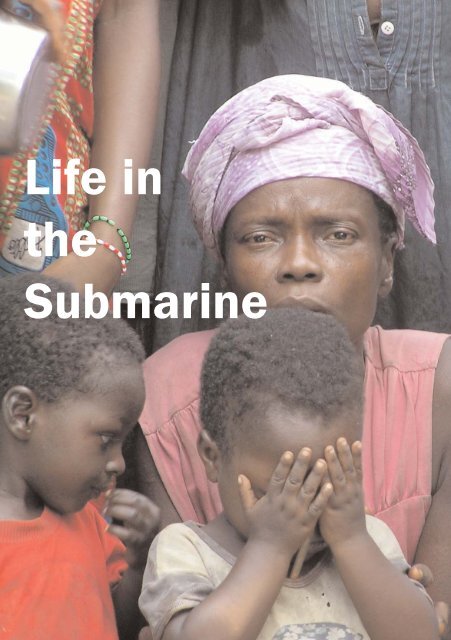

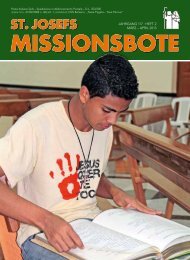
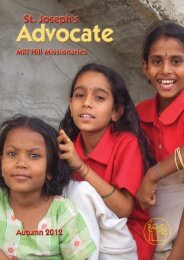
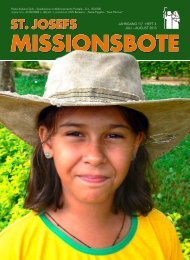

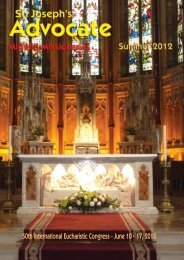
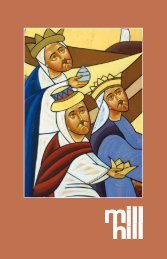
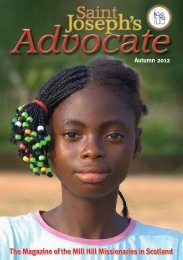

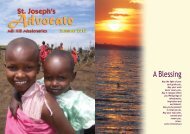
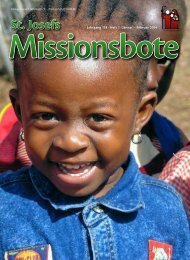
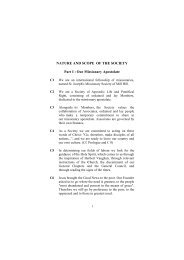

![Summer 2012 [pdf] - The Mill Hill Missionaries](https://img.yumpu.com/43011464/1/184x260/summer-2012-pdf-the-mill-hill-missionaries.jpg?quality=85)